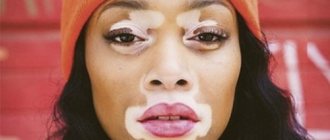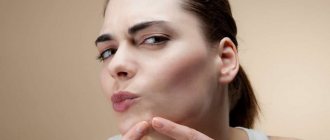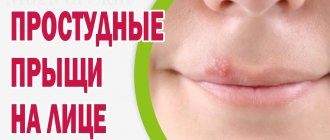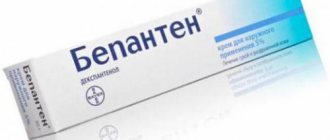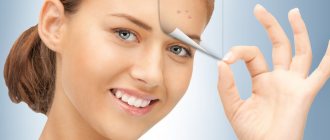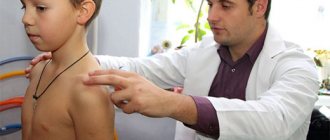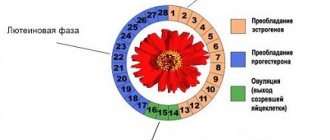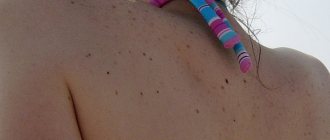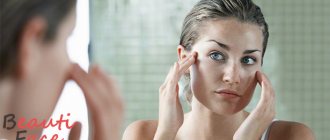Internal acne is most often localized on the face and looks like white or red bumps on the skin. They are less noticeable than ordinary ones, but they are more difficult to deal with; treatment can take several months, because, unlike those formed on the skin, they have no outlet for the pus that has accumulated inside the inflammation. There are many reasons why subcutaneous acne appears on the face. Getting rid of them is quite difficult, and doing it yourself is dangerous.
Why do subcutaneous acne appear?
Deep pimples are rashes on the skin that are common manifestations of acne. They arise as a result of excessive sebum production, blockage of the sebaceous ducts with natural fat. Hereditary predisposition plays an important role in the formation of subcutaneous pimples (pustules). Up to 30% of people aged 14 to 25-30 face a dermatological problem.
The causes of subcutaneous acne are varied, but dermatologists have been able to identify provoking factors:
- Follicular hyperkeratosis is excessive keratinization of the outer layer of skin. Too slow exfoliation of dead cells leads to clogging of skin pores with horny masses. Because of this, the secretion of the sebaceous glands stagnates in the ducts, which leads to the proliferation of bacteria in it and the formation of internal acne.
- Overactivity of the sebaceous glands is an excessive release of natural fat to the surface of the skin. Excessive sebum secretion is one of the symptoms of seborrhea, in which the viscous secretion loses its bactericidal properties.
Subcutaneous acne indicates malfunctions in the functioning of internal organs and systems caused by internal and external causes. Increased secretory activity of the sebaceous glands is provoked by:
- hypovitaminosis;
- unbalanced diet;
- gastrointestinal diseases;
- endocrine disorders;
- abuse of hormonal drugs;
- lack of personal hygiene;
- excessive psycho-emotional stress;
- secondary immunodeficiencies;
- use of comedogenic cosmetics;
- autoimmune disorders, etc.
In women, subcutaneous pustules cause hormonal changes due to menstruation, pregnancy, abortion, menopause, polycystic ovary syndrome, etc. In men, a purulent-necrotic disease - furunculosis - is 2 times more common. It is caused by opportunistic bacteria – Staphylococcus aureus.
The ripening period of such pimples can be quite long, and their presence causes a certain discomfort - they hurt and itch not only when pressed, but also during normal times
The reasons for the formation of subcutaneous large pimples include sloppy shaving, disruption of cellular metabolism, unhealthy lifestyle, and increased sweating.
How to diagnose the cause
Internal acne is diagnosed by a dermatologist during an initial examination. But the principles of treatment are determined by the factors that caused skin inflammation. To find out the causes of internal acne on the face, use the results of the following examinations:
- clinical blood test;
- allergy tests;
- blood test for hormones;
- coprogram;
- test for the presence of demodex.
Small subcutaneous rashes on large areas of the body often indicate the allergic nature of acne. In women, acne is often associated with hormonal imbalance and pathologies of the reproductive system. Therefore, a gynecologist and endocrinologist take part in making a diagnosis and determining the course of treatment for acne.
Small rashes on cheeks and forehead
Very often, small internal pimples and blackheads can appear on the face; there are a lot of them and they form in large quantities. Their formation may be influenced by the following reasons:
- The pores of the face, which are clogged with plugs of accumulated sebum, are dirtier. This environment is considered excellent for the formation of bacteria that influence the formation of the inflammatory process.
- When using low quality cosmetics or products that are already expired.
- Changes in the functioning of the thyroid gland and stomach function.
- Hormonal disruptions in the production of certain hormones.
- Constant climate change, to which the skin reacts so sharply.
- Unhealthy diet, which contains a lot of sweet, salty, smoked foods.
Find out why wen appears on the eyelids.
Here are the reasons for the appearance of wen on the body.
Reviews about removing warts with liquid nitrogen: .
How to quickly get rid of a subcutaneous pimple on the face: first aid
To quickly remove deep acne on the face, use an anti-inflammatory mask with aspirin. It contains acetylsalicylic acid, which has a range of therapeutic properties:
- reduces pain;
- relieves inflammation;
- eliminates redness;
- stimulates the resorption of acne.
Before using the mask, the face is cleansed of impurities with a tonic based on herbal ingredients. Apply the product only to subcutaneous acne once a day. The mask is prepared simply:
- 2 tablets of effervescent aspirin, crushed;
- mixed with 1 tsp. mineral water;
- add 2 tsp. homemade yogurt.
The thoroughly mixed mixture is applied to the acne for 15-20 minutes. Dermatologists do not recommend using the mask if there are purulent-necrotic changes in the skin or salicylate intolerance.
How to treat subcutaneous acne: further therapy
Treatment of subcutaneous acne on the face includes several therapeutic techniques. To combat a dermatological problem you must:
- observe the specifics of caring for problem skin;
- normalize diet;
- use anti-acne products.
As a complement to the main therapy, hardware procedures are used. They are aimed at reducing sebum secretion, eliminating post-acne, strengthening local immunity, and improving the condition of the skin. Also, in the fight against subcutaneous pustules, folk remedies based on herbal components are used.
Features of care
Skin prone to purulent rashes needs proper daily care. If a pimple does not go away for a long time, this indicates insufficient cleansing of the epidermis from dead cells and natural fat.
Step-by-step care:
- Makeup removal. Decorative cosmetics are removed with a cotton pad soaked in micellar water.
- Washing. To cleanse the skin of pathogenic microbes, impurities and fat, use a special foam or gel for washing.
- Exfoliation. To remove dead epidermal cells, a scrubbing cream or gel is applied to the face with massage movements. The procedure is performed no more than 1-2 times a week so as not to damage the skin.
- Hydration. Apply a cream with a light texture or serum to a clean and dry face.
In order for the internal pimple to resolve, it is necessary to perform the procedure twice a day. You should not go to bed with decorative cosmetics on your face. This is fraught with blockage of skin pores, the formation of sebaceous plugs and even greater tissue inflammation.
Nutrition rules
Eating easily digestible carbohydrates stimulates excessive activity of the sebaceous glands.
To remove subcutaneous red pimples, you need:
- replace sugar with dried fruits or fruit jam;
- stop drinking alcohol;
- include lean fish, meat, red and orange vegetables in your diet;
- eat more foods with fiber (white cabbage, lentils, apples, pears, broccoli);
- drink at least 1.5 liters of still water per day;
- limit the consumption of fatty and fried foods, spices.
You need to fight acne constantly, as the disease is chronic. But a balanced and varied diet restores metabolism in the skin and prevents the formation of new inflammatory elements.
Cosmetology procedures
Hardware removal of subcutaneous pustules is one of the most effective and fastest methods of combating acne. To eliminate rashes use:
- Ozone therapy is the injection of ozone gas into the subcutaneous acne area. In 5-6 sessions, internal pustules resolve, damaged tissues heal completely.
- Chemical peeling is a deep cleansing of the skin with acids. The peeling procedure involves the use of fruit acids - pyruvic, lactic, gluconic, etc. In just a few sessions, pimples, peeling, redness and swelling of tissues are eliminated.
- Cryomassage – massage treatment of problem areas with low-temperature nitrogen. Reduces sebum production, increases skin tone, and prevents the formation of internal acne.
For furunculosis, autohemotherapy is indicated, which involves injecting the patient with his own blood.
Medications
Acne is treated with anti-inflammatory, antimicrobial, wound-healing and immunostimulating drugs. To quickly remove subcutaneous pimples, use:
- Clindovit is an anti-inflammatory cream that reduces the concentration of fatty acids in the skin and destroys pathogenic bacteria in the pores;
- Zinerit is an antimicrobial powder that dries out rashes well and stimulates the exfoliation of dead cells;
- Baziron is an ointment for subcutaneous acne that destroys pyogenic bacteria in the sebaceous ducts;
- Skinoren is an anti-acne medicine that reduces the severity of follicular hyperkeratosis.
In severe cases of acne, the affected areas are treated with local retinoids - Roaccutane, Isotretinoin. Also included in the treatment regimen are systemic tetracycline antibiotics - Doxycycline or Minocycline.
Folk remedies
A pimple inside soft tissue is difficult to treat, since it does not reach the surface of the skin. To combat subcutaneous ulcers, agents are used that stimulate the removal of pus to the surface. But before you pull out the pus from the source of inflammation, you need to conduct an allergy test. Sometimes folk remedies cause hives, which worsens the condition of the tissues.
Recipes for anti-acne drugs:
- Potato mask. A small potato is crushed in a blender. The paste is applied to previously cleansed skin for 20-25 minutes. The remains are washed off with a decoction of peppermint or sage.
- Tincture of calendula. 2 tbsp. l. chopped herbs are poured into a glass jar and ½ liter of vodka is poured. Leave in a dark place for at least 10-14 days. The tincture is used as a lotion for wiping subcutaneous pimples in the morning and evening.
- St. John's wort infusion. 10 g of herb is steamed with 250 ml of boiling water and covered with a saucer. After 2 hours, filter the infusion. Moisten gauze and apply to internal pimples for 30 minutes daily.
- Aloe. A few leaves are placed in the refrigerator for a couple of days. Then the problem areas are crushed and treated with a viscous pulp. After 25-40 minutes, the remaining mixture is washed off with boiled water.
For relatively small amounts of acne, it is recommended to use tea tree oil. The product is applied pointwise to areas of inflammation before bedtime.
Treatment
Hard pimples can be more difficult to remove than other types because they tend to be larger and deeper. They are often blind pimples, which means they don't have a head.
Depending on the severity of the pimple, a person can treat it at home, sometimes the pimple needs treatment.
To treat hard pimples at home, a person can use the following methods:
- Cream and ointments. The American Academy of Dermatology recommends over-the-counter creams containing benzoyl peroxide, salicylic acid, and sulfur.
- Warm compress. A warm compress can soften the spot, allowing the pus to rise to the surface. This can also help the blind pimple get to the head.
- Ice packs. Using an ice pack is a good way to reduce inflammation and pain. Ice can be especially effective for hard pimples such as nodules and cysts.
- Cleaners. Some studies have shown that non-soap cleansers are better for treating acne than traditional soap.
- Tea tree oil. A 2007 study found that compared to a placebo, tea tree oil was 3.5 times more effective in reducing the amount of acne lesions and 5.75 times more effective in reducing the severity of an outbreak.
- Vitamin creams. Data on how well these products work is not conclusive, and concentrations of active ingredients such as retinol or zinc may vary depending on the product.
Some research suggests there may be a link between gastrointestinal (GI) health, acne and depression or anxiety. Researchers believe that taking probiotics may help.
Exposure to pimples at home should be avoided, especially when they are hard and deep. Attempts to do this might:
- increase acne
- increased inflammation
- push pus and dirt deeper into the pore.
- increase the risk of infection
- lead to scarring
If a hard pimple is causing distress, your doctor can remove it safely and effectively. They can dry it out, and for deeper acne, use a corticosteroid injection.
Why are internal acne dangerous?
Large painful acne, if not adequately treated, spreads to healthy areas of the skin.
It is believed that if there are 10 or more subcutaneous acne, then it is necessary to treat with medications not only for external, but also for internal use.
They are caused by a bacterial infection that leads to:
- lymphadenitis;
- blood poisoning;
- encephalitis;
- arthritis;
- pyelonephritis.
Less severe consequences of subcutaneous acne include keloid scars. They are connective tissue cords at the site of the former abscess. When you try to squeeze out acne, noticeable pigment spots remain. In some cases, they do not disappear for 1 month or more.
Types
Types of acne include:
- Whiteheads, also known as closed comedones, do not break the surface of the skin.
- Blackheads break the surface of the skin, which is why they are called open comedones. Their black appearance is not caused by dirt, but by air reacting to the inner surface of the pimples.
- Papules. They form when infected skin pores or follicles are located near the surface of the skin. Papules may be sensitive to touch.
- Pustules are similar to papules, but are red and contain pus.
- Nodules are a type of hard pimple that can be large and painful. They form when an infected skin pore or follicle is located deep below the surface of the skin.
- Cysts are found deep under the skin when a pus-filled membrane forms around the infection. They will most likely have scars.
What is prohibited to do
Dermatologists categorically do not recommend:
- Squeeze a deep pimple on your face. Excessive pressure on the skin leads to damage to the capsule, which contains infected pus. Its penetration into surrounding tissues leads to diffuse inflammation.
- Resort to heat therapy. Do not warm subcutaneous pimples with ointments, mustard plasters, compresses with alcohol tinctures, etc. A local increase in temperature is fraught with even greater proliferation of bacteria inside damaged tissues.
- Use corrector pencils. Masking acne with cosmetics leads to clogged pores, which interferes with the outflow of sebum.
Improper treatment of acne only aggravates the skin condition and provokes complications.
Salon treatments
You can normalize your skin condition using salon procedures. However, you can resort to them only when internal acne disappears from the surface of the face. Their use is considered effective in skin regeneration and for subsequent prevention of their appearance. What cosmetic procedures improve the appearance of the skin:
- Peels. They neutralize unfavorable factors that contribute to rashes.
- Galvanization. In this case, the epidermis is exposed to a weak electric current.
- Opening a pimple. The abscess should be opened at a medical center if a nodule dangerous to health has formed. A scalpel is used during the procedure.
There are other procedures that can be performed when acne occurs. One of them is ozone therapy.
It involves introducing a mixture of ozone and oxygen under the skin. Thanks to this manipulation, the pimple matures faster, and the functioning of the sebaceous gland returns to normal. During mesotherapy, a special drug is injected into the epidermis.
Prevention
Subcutaneous pimple is a consequence of disturbances in the functioning of internal organs or systems. The exclusion of provoking factors prevents inflammation of the hair follicles and sebaceous glands. To prevent acne you need to:
- eat a balanced diet;
- monitor immunity;
- wash your face two to three times a day;
- use antibacterial soap;
- do not abuse hormonal drugs;
- treat abrasions and cuts with antiseptics.
Timely treatment of current diseases, proper skin care and compliance with preventive measures prevent excess sebum secretion. But if subcutaneous pimples form, the problem cannot be ignored. Adequate therapy prevents the spread of the rash and purulent complications.

